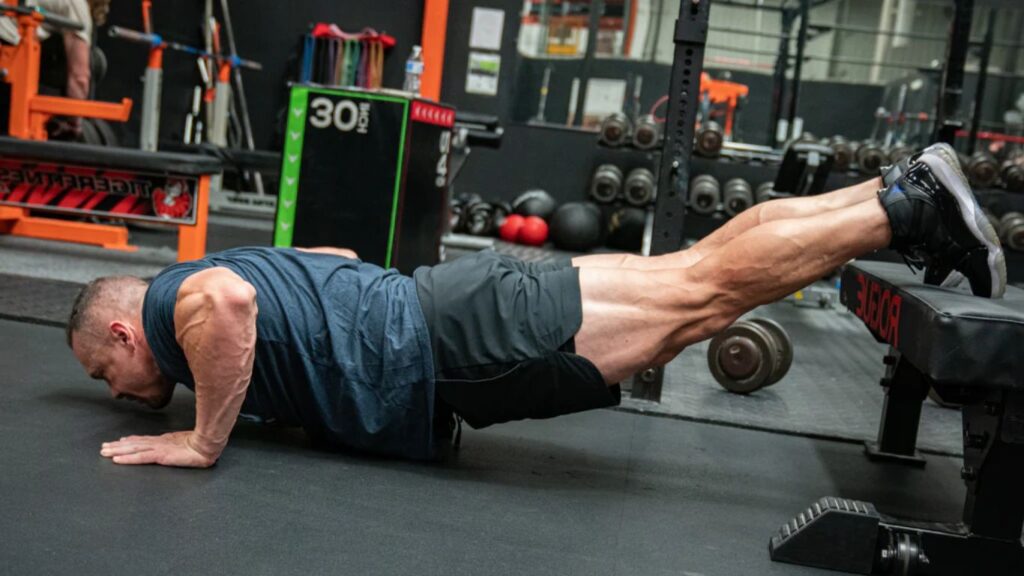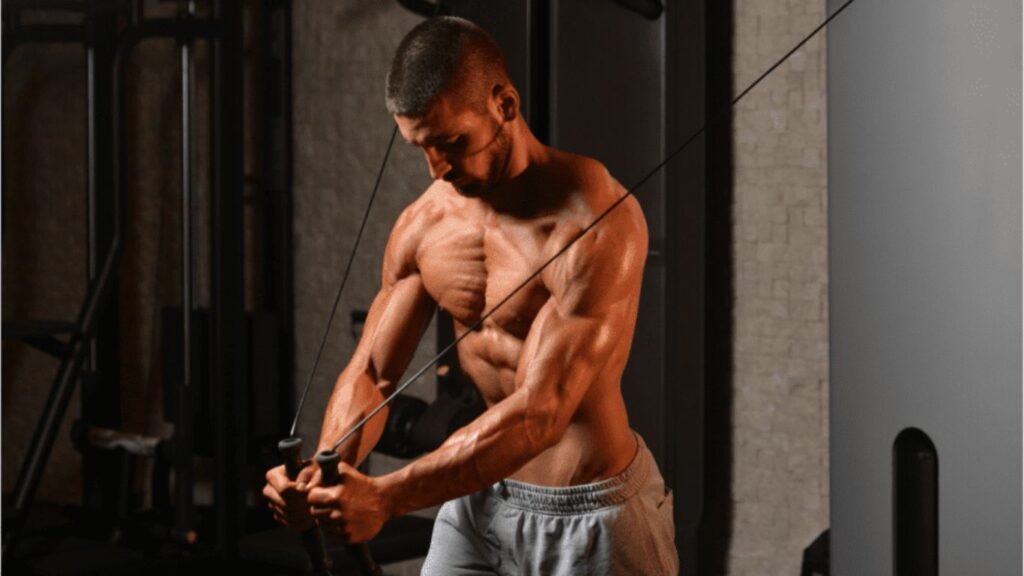Accumulating fat in the lower chest area is a common concern for many, often leading to self-consciousness and dissatisfaction with one’s appearance. This issue isn’t just about aesthetics; it can also have implications for one’s overall health and well-being. Excess fat in this area can be indicative of an unhealthy body fat percentage, potentially increasing the risk of cardiovascular diseases and other health issues. Targeting the lower chest for fat reduction, therefore, serves dual purposes: enhancing physical appearance by achieving a more defined chest and contributing to overall health improvement. This blog delves into this concern by introducing 5 effective Gym workouts that reduces lower chest fats.
Top 5 Effective Gym Workouts to Reduce Lower Chest Fat
Understanding Lower Chest Fat
Fat accumulation in the lower chest can often perplex individuals striving for a toned physique. This predisposition is influenced by several factors, including genetics, which dictates our body’s fat distribution patterns, diet, which impacts our overall body fat percentage, and lifestyle choices. Genetics may predispose some to store more fat in specific areas like the lower chest, while diet and overall body fat percentage play a crucial role in how much fat accumulates. It’s important to debunk the myth of spot reduction; one cannot lose fat from the lower chest alone through targeted exercises. However, these exercises can significantly enhance muscle tone and definition in the area, contributing to a more sculpted appearance as part of a comprehensive fitness strategy.
1: Decline Push-ups
Description of Decline Push-ups:
- Start by placing your feet on an elevated surface (like a bench or step) and your hands on the ground, slightly wider than shoulder-width apart.
- Ensure your body forms a straight line from head to heels, engaging your core and glutes.
- Lower your body towards the ground by bending your elbows until your chest nearly touches the floor.
- Push back up to the starting position, fully extending your arms.

Targeting the Lower Chest:
- Decline push-ups angle the body downwards, shifting the focus and stress towards the lower pectoral muscles.
- This variation increases resistance on the lower chest, providing a challenging workout that aids in sculpting and defining the area.
Tips for Beginners:
- Start with a low elevation to get accustomed to the movement and maintain form.
- Focus on keeping your body straight and avoid sagging your hips to prevent lower back strain.
- Perform the push-ups on your knees if standard decline push-ups are too challenging initially.
Variations for Advanced Individuals:
- Increase the elevation of your feet to amplify the exercise’s intensity and further challenge your lower chest.
- Incorporate a weighted vest for added resistance and to increase the difficulty.
- Try performing the push-ups with one leg lifted to engage the core more and add an extra balance challenge.
2: Cable Crossovers
Proper Execution of Cable Crossovers:
- Start by setting the pulleys on a cable machine to the highest position.
- Grasp the handles with palms facing down, standing in the middle of the machine with one foot slightly in front of the other for stability.
- Lean slightly forward from your waist, keeping your back straight and a slight bend in your elbows.
- Bring your hands together in a wide arc in front of you, focusing on using your chest muscles to pull the cables.
- Slowly return to the starting position, allowing your chest to stretch.

Benefits for Sculpting the Chest:
- Targets the pectoral muscles from various angles, enhancing muscle definition and size.
- Improves muscle symmetry by allowing each side of the chest to work independently.
- Engages the inner chest muscles, which are often hard to isolate with other exercises.
Safety Tips and Adjustments:
- Start with lighter weights to focus on form and prevent injury.
- Keep movements controlled and avoid jerky motions to reduce the risk of strain.
- Adjust the cable height and standing position to target different parts of the chest, such as setting the pulleys lower to focus on the upper chest.
- Ensure a slight bend in the elbows throughout the exercise to protect the joints.
3: Decline Bench Press
Step-by-Step Guide to Performing the Decline Bench Press:
- Secure your legs at the end of the decline bench and lie down with your eyes under the barbell.
- Grasp the barbell with a grip wider than shoulder-width, wrapping your thumbs around the bar for safety.
- Lift the bar from the rack and hold it straight over your chest with arms locked.
- Slowly lower the bar to your lower chest, keeping the movement controlled and elbows at about a 45-degree angle from your body.
- Press the bar back up to the starting position, focusing on using your chest muscles to drive the movement.

Effectiveness for Targeting Lower Chest Muscles:
- The decline angle specifically emphasizes the lower pectoral muscles, aiding in developing a well-rounded and sculpted chest.
- It allows for a greater range of motion compared to flat and incline presses, providing a more intense workout for the lower chest.
Variations in Grips and Angles for Diversity:
- Altering the grip width can shift the focus slightly between the inner and outer lower chest muscles. A closer grip targets more of the inner lower chest, while a wider grip focuses on the outer portions.
- Incorporating different decline angles, if possible, can help to further isolate and work the lower chest muscles from various perspectives, ensuring all parts of the lower chest are engaged and developed evenly.
- Using dumbbells instead of a barbell for decline presses can offer a different stimulus to the muscles, promoting balance and coordination while still targeting the lower chest effectively.
4: Dumbbell Pullover
Technique for Dumbbell Pullovers:
- Lie on a bench with your upper back and shoulders supported, feet flat on the ground, hips below the bench level.
- Hold a dumbbell with both hands straight above your chest, palms pressing against the underside of one of the dumbbell ends.
- With a slight bend in your elbows, slowly lower the dumbbell back and over your head until your upper arms are in line with your torso, stretching your chest and ribcage.
- Bring the dumbbell back to the starting position, focusing on using your chest and back muscles to perform the movement.

Muscles Targeted by Dumbbell Pullovers:
- Primarily works the pectoralis major (chest) and the latissimus dorsi (back), providing a unique workout that bridges upper body muscle groups.
- Also engages serratus anterior, triceps, and deltoids for a comprehensive upper body strengthening exercise.
Dual Benefits for Chest and Back:
- Offers the advantage of simultaneously targeting and defining both chest and back muscles, making it an efficient addition to any upper-body workout routine.
- Enhances thoracic mobility and can aid in expanding the ribcage if performed regularly.
Advice on Maintaining Form:
- Ensure to keep the movement controlled and slow to maximize muscle engagement and prevent injury.
- Avoid locking your elbows to protect your joints and maintain tension on the targeted muscles throughout the exercise.
- Do not lower the dumbbell too far to avoid overstretching and potential strain. Keeping the movement within a comfortable range of motion will maximize benefits and safety.
- Focus on breathing deeply throughout the exercise; inhale as you lower the dumbbell and exhale as you return to the starting position.
5: Chest Dips
Performing Chest Dips:
- Begin by gripping parallel bars or a dip station with your arms straight and shoulders above your hands.
- Lean forward slightly, keeping your elbows close to your body as you lower yourself until your shoulders are below your elbows or you feel a stretch in your chest.
- Push yourself back up to the starting position, focusing on using your chest muscles to drive the movement.

Effectiveness for the Lower Chest:
- Chest dips emphasize the lower pectoral muscles due to the forward lean and the movement’s depth, making them highly effective for developing this area.
- The exercise also engages the triceps and shoulders, offering a compound workout that supports overall upper body strength.
Variations with Equipment:
- At the gym, use a dip station or parallel bars designed for chest dips.
- At home, use two sturdy chairs or a low, stable bar to perform the exercise.
Tips for Increasing Intensity:
- Add weight using a dip belt, weighted vest, or by holding a dumbbell between your feet to increase resistance as your strength improves.
- Experiment with slowing down the descent or pausing at the bottom of the dip to increase muscle time under tension.
- Try different grip widths (if possible) to slightly alter the muscle focus or increase the challenge of the movement.
- Incorporate chest dips at the beginning of your workout when you’re freshest to push your limits and stimulate muscle growth effectively.
Also read: Understanding the Culprits: What Causes a Bulging Belly?
